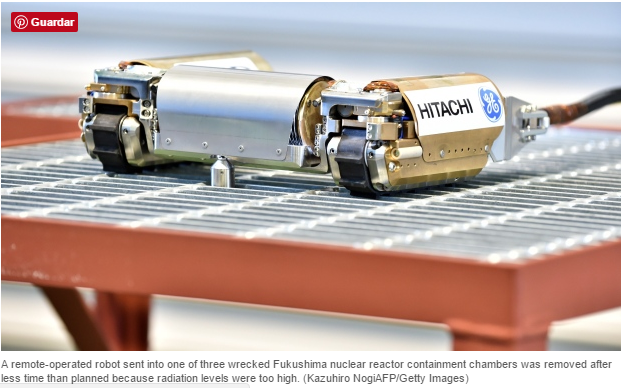When the earthquake and resulting tsunami hit Japan in 2011, the world didn’t initially realize the amount of damage that had been done to the Fukushima nuclear power plant. Located near the ocean, the tsunami was powerful enough to overcome protective barriers and knock out the cooling system that was critical to keeping the nuclear fuel cool. Without this cooling system in place, the reactors experienced meltdowns and explosions took place, hurling radioactivity into the air and eventually contaminating the ground water.
Now we are getting news that matters are even worse than imagined.
The Japan Times reports authorities have measured extremely high levels of radiation inside one of the damaged reactors at the Fukushima nuclear reactor:
The radiation level in the containment vessel of reactor 2 at the crippled Fukushima No. 1 power plant has reached a maximum of 530 sieverts per hour, the highest since the triple core meltdown in March 2011, Tokyo Electric Power Co. Holdings Inc. said…
According to the [National Institute of Radiological Sciences], 4 sieverts of radiation exposure would kill 1 in 2 people.
“Sieverts” is the term now used to measure levels of radiation exposure. Clearly the amount of radiation being given off by one of Fukushima’s damaged reactors is incredibly deadly. And there is no way to just “shut it off.”
What might comes as a surprise is not that exposure to this level of radiation is deadly after only minutes of exposure, but that it can destroy machinery as well. Hence, sending in robots to fix the problem is not the obvious solution it would appear to be.
Despite the high levels of radiation, the Washington Post points out that this is probably not an indication that radiation levels have increased at the plant. The Post quotes Azby Brown of Safecast, which it describes as a “citizen science organization that monitors radiation levels”:
While 530 Sv/hr is the highest measured so far at Fukushima Daiichi, it does not mean that levels there are rising, but that a previously unmeasurable high-radiation area has finally been measured. Similar remote investigations are being planned for Daiichi Units 1 and 3. We should not be surprised if even higher radiation levels are found there, but only actual measurements will tell.
More on the problem of using robots to do the work of containing the radioactive leaks:
A remote-controlled cleaning robot sent into a damaged reactor at Japan’s Fukushima nuclear plant had to be removed Thursday before it completed its work because of camera problems most likely caused by high radiation levels.
It was the first time a robot has entered the chamber inside the Unit 2 reactor since a March 2011 earthquake and tsunami critically damaged the Fukushima Da-ichi nuclear plant.
If this is an area where the radiation is too high even for robots, the options for fixing the problem get even more limited. In fact, current robots can only stand at most two hours of the level of radiation experienced before breaking down.
After about two hours, the two cameras on the robot suddenly developed a lot of noise and their images quickly darkened — a sign of a problem caused by high radiation. Operators of the robot pulled it out of the chamber before completely losing control of it.
The outcome means the second robot will encounter more obstacles and have less time than expected for examination on its mission, currently planned for later this month, though Thursday’s results may cause a delay.
This has been a disaster from the time the tsunami first hit six years ago. It continues to defy efforts to contain the radiation or prevent it from leaking into the Pacific Ocean. If it does take another 40 years to get this cleaned up, what will be the eventual impact on the Pacific and the populations along its border?
Source: Hot Air
Source: CBC News


The Chernobyl reactor was encased in concrete.
They have had to redo it.
Because the radiation inside is so ungodly, it ate up the concrete. They’ve put a new structure over the reactor now. It looks like an airplane hanger.
We’ll see how long that one lasts.
not one thing on the news and why nothing from or government
We are so screwed
And it’s coming to america . This the most dangerous kind of energy .
I see where it is in the Salmon too.
This is sad and it’s killing the ocean off . It’s already here it’s just the media is silent .The media is more worried about controlling the reality show from the election and our new president . Everyone is all worried about the environment with emissions yet this is one of the worst disasters in history kept silent . If we don’t become radioactive we will run out of air since the oceans give us most of our air .
Watch out West Coast.
Yea no kidding and also stop eating Sushi and tuna .
Gloria Pegler don’t forget the mid-west
Ah, but isn’t this what happens when greed driven American engineers are allowed to oversight and build nuclear facilities in the most earthquake prone and populace regain on earth? I’m surprised Japan fell for it. Especially considering there are far older and much more full proof designs for said being totally ignored. One in particular, the liquid metal core system that automatically shuts itself down. Oh, but how that money talks…. and greases palms, and gets people killed…..